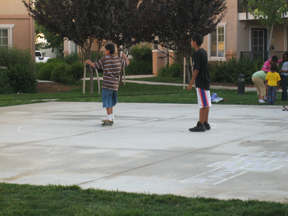
Transitional housing centers offer hope for families
The John H. Boccardo Family Living Center on Monterey Road in
San Martin, just across from the train station, and the Sobrato
Family Living Center in Gilroy look like any other apartment
complexes. They are painted in bright peachy colors and have
buildings clustered around common areas away from the parking lots.
Children can be seen running around the grassy parts of the complex
on sunny afternoons.
Transitional housing centers offer hope for families
The John H. Boccardo Family Living Center on Monterey Road in San Martin, just across from the train station, and the Sobrato Family Living Center in Gilroy look like any other apartment complexes. They are painted in bright peachy colors and have buildings clustered around common areas away from the parking lots. Children can be seen running around the grassy parts of the complex on sunny afternoons.
But unlike apartment complexes, families staying at Boccardo and Sobrato are offered more than just a place to live. The family living centers are run by EHC Lifebuilders, a nonprofit based in Silicon Valley that works with homeless populations.
At the Boccardo Family Living Center, families receive individualized case management that can include classes on life skills and improving English skills. In addition, children are engaged in recreation programs and can even get tutoring on their school work.
When it comes to dealing with the issue of homelessness, many nonprofits are taking a step beyond simply offering a bed for the night. Dubbed transitional housing, the movement is away from just getting people off the streets during bad weather to one that offers a semi-permanent place to stay as well as resources so that people won’t end up back on the streets in the future.
In San Benito County there is no transitional housing like the Gilroy and San Martin living centers. There is a seasonal emergency shelter that opens after Thanksgiving and a women’s shelter for victims of domestic violence that sometimes houses women and children without a place to live on a temporary basis. The Homeless Task Force, a group of community leaders that includes Mayor Doug Emerson, David Huboi, a planning commissioner, and Cathy Ruiz, has talked about opening up a year-round shelter, but a lack of funds has kept the movement from going forward.
The program at Boccardo worked for one family who shared their story in an EHC annual report from 2006. When Veronica and Fernando Costas first came to the United States from Mexico, Fernando found a job working in a nursery and the family lived in one small room provided by his employer.
They first heard about EHC Lifebuilders from a nurse who treated their children for an illness caused by toxic mold in their small home. They were accepted into the program, where staff taught Fernando how to search for a job online. Veronica attened the ESL classes on site and applied for a childcare provider license. They sent their children to the tutoring sessions.
Most importantly, the couple opened their first savings account while living at the center and by the time they left the program a year later they had saved $5,000 to put toward buying their own home in Morgan Hill. A cornerstone of the program is that residents pay a minimal rent so that they can save for their futures.
One thing that has made EHC programs successful is a large outpouring of support from private corporations and public agencies in the region. More than 40 percent of their revenue comes from government agencies and 12 percent comes from private donations from foundations or corporations, according to the most recent annual report published in 2006. Just 23 percent comes from rent and fees charged to clients.
Path Partners, a nonprofit based in Los Angeles has similar support from a variety of sources for their homeless housing programs, which include transitional housing as well.
As with the Sobrato and Boccardo centers, Path Partners offers housing as well as life skills training and other support services. The Rhonda Fleming Family Center houses families with children while other sites cater to single men and women; teens who have aged out of foster care; and men living with HIV/AIDS.
In May, Mary Bains-Fort and her husband Wesley Fort, two local residents who have said they want to offer transitional housing in Hollister, visited a Path Partners site in Los Angeles. According to an internal news piece posted on Path Partners Web site, the couple said they planned to use Path as a model for a similar regional transitional housing center that would provide for homeless and people at risk of homelessness in San Benito, Santa Clara and Monterey Counties.
Information compiled from www.pathpartners.org and www.ehclifebuilders.org.









